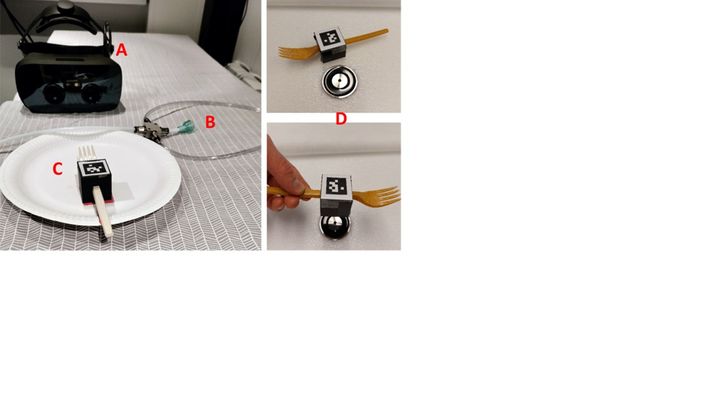Extended reality to help produce eco-friendlier food
Extended reality makes it possible to artificially modify human sensations. For example, researchers have succeeded in using extended reality to make vegetarian food even more attractive.
“This could be one way of facilitating more ecologically diverse food production and, at the same time, encouraging people to eat healthier,” says Roope Raisamo, a professor in human-technology interaction at Tampere University, who has been carrying out research on extended reality for different use cases with funding from the Research Council of Finland (RCF) for years.

Extended reality (XR) refers to all environments where reality meets the virtual world. It includes techniques such as augmented reality (AR), virtual reality (VR) and mixed reality (MR).
Raisamo’s research group recently completed a project that examined the impact of XR on the experience of eating food. The food research was led by Research Professor Nesli Sözer at VTT Technical Research Centre of Finland Ltd. The goal was to create eating experiences and new food items that people would find pleasant and that would give them a feeling of satiety. This could help make foods such as seaweed become more widely used in food preparation.
One experiment studied how introducing meat flavours to plant-based ‘meatballs’ changed the eating experience. By means of XR, a simple olfactory display added a pleasant fragrance to the meal. This side of the study was implemented by Raisamo’s group.
“The premise was to bring two previously rarely collaborating disciplines together to do something completely new,” says Raisamo. He has studied the use of haptic sensations in XR extensively.
Extended sensory experiences may be a future element in marketing and communication
“In the future, the olfactory and haptic sensations introduced by extended reality can be used in marketing and communication, for example. They’re not yet widely available, but some time from now, it will be quite possible to add modules that produce scents and haptic sensations to users’ devices. Haptic devices, meaning devices that produce touch sensations, are already on the market, but they’re not yet available to everyone,” says Raisamo. For example, social media channels favoured by young people could utilise these as part of communication.
Multisensory interaction is one of the strongest areas of Raisamo’s team. They had used artificial intelligence in their research long before AI became the phenomenon it is now. At present, Raisamo uses RCF funding to study the augmentation of a person’s functional capacity and situational awareness of where they are and what is happening. This project is also being implemented in cooperation with VTT. The University of Lapland is involved, as well.
“The results allow for the optimal use of extended reality systems through human-AI cooperation. We measure cognitive responses, task completion and user experience when a user interacts with an AI-based extended reality. We combine cognitive space modelling, detection, personalisation and forecasting with modelling, contextual awareness and adapting interaction methods,” Raisamo says, describing the project.
Raisamo has been carrying out research with RCF funding since 2001. Business Finland and the EU have also provided him with extensive funding.
Raisamo leads TAUCHI, the Tampere University Computer-Human Interaction Research Centre, which has 90 researchers in total. Raisamo’s own group includes 20 researchers. TAUCHI’s mission is to improve human-technology interaction by producing knowledge and solutions based on the natural ways people communicate.
Inquiries and more information:
- Roope Raisamo, Professor of Computing Sciences, Tampere University, tel. +358 50 570 2007, roope.raisamo@tuni.fi
- Article on the effects of sensory augmentations on food, published in the Journal on Multimodal User Interfaces
- Tampere University Computer-Human Interaction Research Center
Keywords
Contacts
Research Council of Finland Communications
Leena Vähäkylä, Communications Specialist
tel. +358 295 335 139
firstname.lastname(at)aka.fi
Links
The Research Council of Finland
The Research Council of Finland is an expert organisation in science and research. We fund high-quality scientific research, provide expertise in science and science policy and strengthen the position of science and research. We are a government agency within the administrative branch of the Finnish Ministry of Education, Science and Culture.
Subscribe to releases from Research Council of Finland
Subscribe to all the latest releases from Research Council of Finland by registering your e-mail address below. You can unsubscribe at any time.
Latest releases from Research Council of Finland
Consortia selected for second stage of SRC programme call18.3.2025 14:39:20 EET | Tiedote
The Strategic Research Council (SRC) established within the Research Council of Finland has invited 28 consortia to the second stage of the SRC programme call.
RCF publishes call documents and review guidelines for spring call5.3.2025 15:34:24 EET | Tiedote
The Research Council of Finland (RCF) today published the call texts for the 2025 spring call. The call texts are available in English, Finnish and Swedish. The review guidelines and forms are only available in English.
3,323 applications submitted to Research Council of Finland’s winter call14.1.2025 12:09:44 EET | Tiedote
The Research Council of Finland’s winter call 2025 closed on Wednesday 8 January with a total of 3,323 applications submitted. The total number includes consortium subprojects as separate applications. If each consortium is counted as a single application, the total number of applications comes to 2,846.
Research utilisation gets major lift with RCF funding29.11.2024 11:12:30 EET | Tiedote
The Research Council of Finland (RCF) has awarded a total of 10 million euros to 32 projects, in all 39 subprojects, in the Proof of Concept call. The application success rate was 17 per cent.
Research Council of Finland invests funding in Antarctic research21.11.2024 11:59:59 EET | Tiedote
The Research Council of Finland today announced some 3 million euros in funding under the call for Antarctic research projects, which was open in April 2024.
In our pressroom you can read all our latest releases, find our press contacts, images, documents and other relevant information about us.
Visit our pressroom